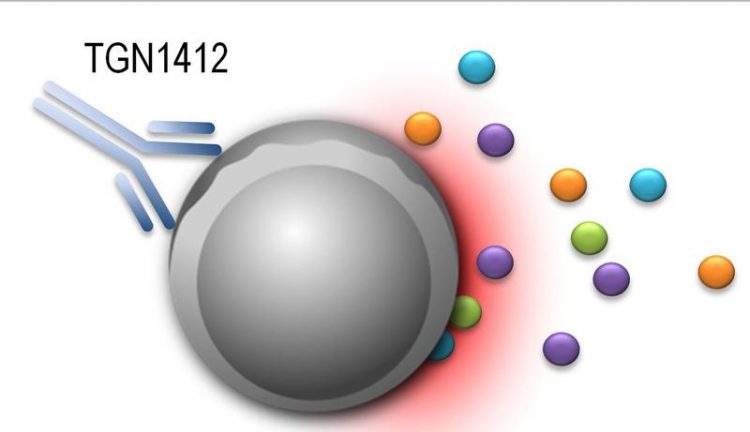Mouse model suitable for predicting cytokine storm by antibodies such as TGN1412

In the focus: T-cell-mediated immune-reactions caused by monoclonal antibodies such as TGN1412 Source: PEI
TGN1412 – the effects of the clinical trial with this humanised “superagonistic” monoclonal antibody can still be felt today. TGN1412 was developed for the treatment of rheumatoid arthritis and a particular form of leukaemia.
In 2006, the antibody was administrated in a first-in-man study to six healthy volunteers in the UK. All volunteers developed massive release of immunological messenger substances (cytokine storm) with life-threatening symptoms only a short time after they received TGN1412.
In the preliminary animal experiments – an important component of the required studies before first use in humans – no risks became apparent. The severe immunological reactions thus came as a surprise.
For this reason, since this event, researchers have been seeking methods of studying and estimating such severe adverse effects as a result of immunological reactions before first use in humans. Immunologists of the Paul-Ehrlich-Institut (PEI) who are supervised by and collaborating with Priv.-Doz. (associate professor) Dr Zoe Waibler, head of a temporary research group, investigated whether a humanised mouse model could be suitable for this.
They used so-called knock-out mice, in which specific genes of the immune system of the mouse are deactivated. These mice are substituted with cells of the immune system from human blood.
In addition to TGN1412, the scientists also used the monoclonal antibody OKT3, of which it is also known that it can cause severe cytokine storms. The scientists were able to detect cytokine release in the blood samples of the animals for both antibodies. Thus, for instance interferon-gamma levels increased considerably after the administration of the antibody.
Besides, the scientists observed additional effects equivalent to those observed in humans. These included the loss of leucocytes (white blood cells) after the administration of TGN1412 and the typical loss of particular surface markers (CD3) on T cells typically observed after the administration of OKT3. These cells play an important part in the human immune system.
However, what was a lot more obvious related to the clinical symptoms: The body temperature of the animals decreased. This is a sure sign of disease in mice comparable to high temperatures in humans. The general state of health of the mice, too, deteriorated significantly in only few hours. “Based on the symptoms and the blood samples in this mouse model, we can see adverse effects at an early stage without having to know in detail in advance what exactly we are looking for. This is a significant use of the mouse model”, as Ms Waibler explained the results.
This animal model, above all, makes immunological effects visible which are mediated via T cells of the immune system. Even though the animal model involves a high workload, it opens up options of approaches to improving safety before first use in humans during clinical trials of monoclonal antibodies, for which a T-cell-mediated reaction could be expected and for which a severe immune reaction must be ruled out.
Original Publication
Weißmüller S, Bauer S, Kreuz D, Schnierle B, Kalinke U, Kirberg J, Hanschmann KM, Waibler Z (2016): TGN1412 induces lymphopenia and human cytokine release in a humanized mouse model.
PLOS ONEMar 9 [Epub ahead of print].
DOI: 10.1371/journal.pone.0149093
http://dx.plos.org/10.1371/journal.pone.0149093 – Online-Version of the Publication
http://www.pei.de/EN/information/journalists-press/press-releases/2016/07-mouse-… This press release on the PEI-Website
Media Contact
All latest news from the category: Life Sciences and Chemistry
Articles and reports from the Life Sciences and chemistry area deal with applied and basic research into modern biology, chemistry and human medicine.
Valuable information can be found on a range of life sciences fields including bacteriology, biochemistry, bionics, bioinformatics, biophysics, biotechnology, genetics, geobotany, human biology, marine biology, microbiology, molecular biology, cellular biology, zoology, bioinorganic chemistry, microchemistry and environmental chemistry.
Newest articles

Compact LCOS Microdisplay with Fast CMOS Backplane
…for High-Speed Light Modulation. Researchers from the Fraunhofer Institute for Photonic Microsystems IPMS, in collaboration with HOLOEYE Photonics AG, have developed a compact LCOS microdisplay with high refresh rates that…

New perspectives for material detection
CRC MARIE enters third funding period: A major success for terahertz research: Scientists at the University of Duisburg-Essen and the Ruhr University Bochum have been researching mobile material detection since…

CD Laboratory at TU Graz Researches New Semiconductor Materials
Using energy- and resource-saving methods, a research team at the Institute of Inorganic Chemistry at TU Graz aims to produce high-quality doped silicon layers for the electronics and solar industries….



